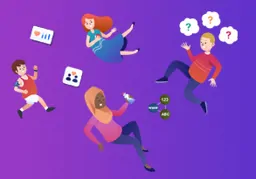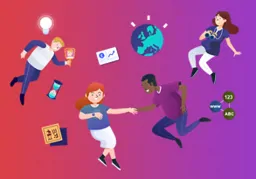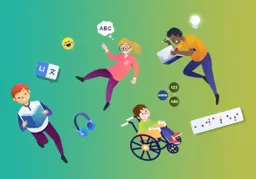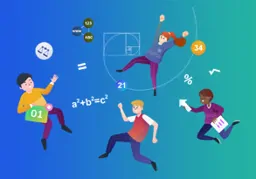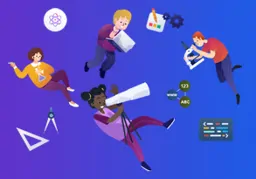AREA OF LEARNING AND EXPERIENCEExpressive Arts
Guidance to help schools and settings develop their own curriculum, enabling learners to develop towards the four purposes.
5. Designing your curriculum
This provides specific guidance to be used when incorporating learning in the expressive arts in your curriculum. It should be read together with the overarching Designing your curriculum section which is relevant to learning and teaching across all areas of learning and experience.
Cross-curricular skills and integral skills
A curriculum must embed the mandatory cross curricular-skills and the integral skills which underpin the four purposes of the curriculum. Below are some key principles which settings/schools should consider when designing learning and teaching in the Expressive Arts Area of Learning and Experience (Area).
Cross-curricular skills
Literacy
From exposure to and involvement in this Area, learners develop skills that are essential for the critical analysis and use of language receptively and expressively. Learning and experience in this Area provides a range of purposeful and rich contexts where learners’ literacy skills can be reinforced, developed, applied and extended. Exploration and exposure to a variety of creative work can be powerful in the development of reading strategies and higher-order reading skills, such as inference and deduction. It is a versatile platform for learners to acquire the skills and knowledge to adapt their language for audience and purpose and provides purposeful opportunities for building confidence so that learners can express themselves as individuals and in role.
Numeracy
This Area provides creative opportunities to develop numeracy skills in a range of engaging contexts. Learners communicate with symbols and use a range of mathematical language. They explore concepts related to geometry and measurement such as size, shape, symmetry, scale, length, dimension, distance, position, viewpoint and time. They also explore concepts related to number such as structure, pattern and rhythm, counting, repetition, phrasing and financial literacy.
Digital competence
This Area provides a wealth of opportunities to develop digital competence in areas such as digital collaboration, production technology, intellectual property, artificial intelligence, digital rights, licensing and ownership, body image and photo editing, as well as the saving, sharing and distribution of digital work.
Integral skills
Creativity and innovation
The creative process is the essence of this Area. The statements of what matters enable learners to develop knowledge, and creative and innovative skills. Learners are expected to consider influences and shape their own creativity. Learners use their creative skills and imagination, discover possibilities and refine ideas to produce their own unique artistic work. Creative thinking developed by exploring within and through this Area enables learners to investigate the unknown and make connections. Learners take creative risks to go beyond existing knowledge and accept failure as a learning experience.
Critical thinking and problem-solving
Refining work is encouraged throughout one of the statements of what matters in this Area, with the aim of building skills in self-evaluation and reflection. The evaluation involved in the creative process enables learners to develop reflective, questioning and problem-solving skills, as well as to challenge perceptions and identify solutions. Learners may demonstrate resilience in applying critical appraisal of their work and be expected to respond positively to critical feedback. Learners can develop problem-solving skills by experimenting with a variety of arts and artistic techniques.
Personal effectiveness
Through the statements of what matters in this Area, learners develop self-confidence, self-esteem, independence, communication skills and social and cultural awareness. Learners become enterprising, resourceful and resilient by managing themselves and their resources, and this in turn enhances their employability skills. They are encouraged to develop resilience through accepting failure and value its place in the creative process.
Planning and organising
Through this Area, learners are encouraged to plan, set their own goals and manage resources. They can apply reflective, critical and creative processes to make sense of ideas and experiences. The ability to generate ideas, develop curiosity, explore and bring ideas into action is fundamental to this Area.
Specific considerations for this Area
The statements of what matters in this Area represent the creative process. Through the creative process, learners explore, respond to stimuli and create and reflect on their own work while engaging in rich, authentic experiences.
This Area spans the five disciplines of art, dance, drama, film and digital media, and music. These disciplines share the creative process, and each contributes transferable skills and knowledge to a learner's experience. In addition, each discipline has its own discrete body of knowledge and body of skills ; this learning supports progression and offers greater depth to learning. This Area is designed to support the development of a more integrated approach to learning.
There is flexibility in how a school may decide to structure its curriculum, such as through an integrated, multidisciplinary, interdisciplinary or disciplinary approach. Across the learners' journey on the 3 to 16 continuum, it is important to offer broad and balanced opportunities for art, dance, drama, film and digital media and music. The delivery should be adaptive, versatile and change depending on the learners and their context.
Regardless of the approach chosen, it is important to note that the statements of what matters are interlinked and should not be taught in isolation. Together they allow learners to engage fully with the creative process which each of the expressive arts’ disciplines has in common.
Considerations when designing your curriculum:
- equitable opportunities to include the five disciplines of art, dance, drama, film and digital media and music
- progression along the continuum – complexity, control, depth and independence
- experience, knowledge and skills inherent to and across each discipline
- opportunities to work independently and collaboratively
- a range of stimuli, techniques, materials and resources, tools and technologies
- styles, genres and creative texts across all disciplines and spanning people, places, cultures and time
- discipline-specific vocabulary and skills
- experience of actual and virtual venues, and local, national and international arts events and festivals
- critical appreciation and response
- input from creative professionals and industry experience
- access to local, national and international contexts
- access to practical and theoretical exploration
- opportunities for learners to take on a range of roles and responsibilities within the creative process
Illustrating breadth
The following are provided as examples of how you could explore different topical learning in this Area. These are illustrations only.
This Area could include exploring not only the artistic techniques and impact of creative work by Bob Dylan, Joseph Parry and The Joy Formidable, but engaging with the social influences, context and narrative of those works to inspire learners’ own work.
The art of Ceri Richards, Martin Parr and Mary Lloyd Jones has a distinct relationship to Wales, this could be an inspiration for learners developing their own understanding and creative skills.
The films Tiger Bay, House of America, and Solomon a Gaenor each portray different Welsh experiences and communities, learners could use these to recognise and analyse character, identity and place, as they challenge and develop their own identities and imagination through the arts.
Discipline-specific considerations
Experience, knowledge and skills inherent to each discipline are included in progression steps 1 to 5 with increasing levels of complexity. These include but are not limited to the following:
Art
Art includes the experimentation and development of an almost limitless range of resources, materials, techniques and processes across all types of art, craft and design to produce a range of outcomes and to demonstrate a personal and creative response.
You should consider:
- line, shape, texture, colour, design, form (2D, 3D, 4D), pattern, tone, shading, space, contrast, proportion, composition, scale, perspective
- architectural design, advertising, animation, constructed textiles (knitting/weaving/embellishment), ceramics, craft, design, drawing, environmental/landscape art, fashion, fine art, communication graphics, jewellery and body adornment, illustration, interactive design (including web, app and game), interior design, installation, live art, making, mixed media, moving image, multi-media, package design, painting, photography, print-making (relief/intaglio/screen processes/lithography), signage, sculpting, sound art, surface pattern, textiles, typography, video
Dance
Dance includes performing, choreography and appreciation across a range of styles.
You should consider:
- movement framework (body actions, space, dynamics, relationships), time (rhythm and phrasing), improvisation, character, motifs/phrases
- choreographic devices (unison and canon, repetition, variation and development, complementary and contrasting, climax, highlights)
- compositional structures (beginning, middle and end, binary, ternary, rondo, theme and variation, narrative, unity, logical sequence, transitions)
- dance compositions (pure, abstract, lyrical, dramatic, comic, dance-drama)
- performance/refinement including physical elements (actions, posture, alignment, balance, coordination, control, flexibility, mobility, strength, stamina, extension, isolation)
- expression (projection, spatial awareness, musicality, phrasing, facial expression, interpretation, communication)
- technical considerations (timing, reproduction of movement in a stylistically accurate way)
Drama
Drama includes acting, directing, design, technical theatre and arts administration.
You should consider:
- plot, character, thought, relationships (which encompasses interaction), tension, focus, place, time, language, voice (which encompasses accent, diction, pitch, tempo, pauses), movement (which encompasses gesture, facial expressions), proxemics, atmosphere, mood, symbols, design which encompasses stage lighting, sound, set, hair, make-up, costume, script writing, directing and stage management
- comedy, tragedy, tragicomedy, farce, musical theatre, melodrama, mime, physical theatre
Film and digital media
Film and digital media includes television, film, radio, games design, photography, live events and theatrical production skills, print media, social media, sound and audio production.
You should consider:
- editing, post production, 3D space, 2D space, sound, lighting, camera, narrative, style, genre, audience, composition (visual, virtual and sonic), form (animation, live action, audio, written), virtual reality
- sound, video/film (animation, documentary, narrative, music video), print media, radio/podcast, photography, graphics, virtual forms, linear forms, non-linear forms, interactive media, social media, audio production and design, lighting design, stage design, social media, game design, event design, production design
Music
Music includes performing, improvising and composing, listening and appreciation.
You should consider:
- pitch, melody, dynamics, texture, tempo, timbre, rhythm, metre, form and structure, tonality, musical devices (e.g. repetition, ostinato, sequence), harmony, intonation
- binary, ternary, rondo, round, minuet and trio, strophic, theme and variation, through-composed, sonata
- performing (including vocal, instrumental, technology e.g. DJ-ing), improvising and composing (including vocal, instrumental, acoustic, electric and digital, editing/production), listening (including analysing, evaluating, and appreciating a range of musical forms and styles across genres and periods of time)
Key links with other Areas
When designing your curriculum, you should consider how learning links across Areas. The creative process, as exemplified in the statements of what matters in this Area, can be used across all other Areas to enhance, stimulate and support learning. Equally, expressive arts’ skills and knowledge can be developed through other Areas. Some of the key links to learning in this Area are detailed below.
The Health and Well-being Area of Learning and Experience provides opportunities for creative movement and dance as a physical activity and can enable learners to develop gross motor movements and fine motor movements to support participation in the arts’ disciplines. Involvement in the expressive arts can enable learners to develop a sense of self, build confidence, and explore different forms of communication and relationships which can support mental health and emotional well-being.
Art, music, dance, theatre, forms of media and literature are valuable pieces of evidence for enquiries in the humanities and are mediums for expression of people’s interpretations and viewpoints. The natural world, the past and present all act as stimuli and contexts in the Expressive Arts Area of Learning and Experience. Throughout the past, and present the expressive arts have been important in shaping culture and societies. Exploring the arts from various times, cultures and societies, including from Wales (e.g. Eisteddfod), allows learners to develop their understanding of other cultures as well as their own. Exploration of social and ethical concepts, sustainability and business can act as a stimulus for creative work.
Languages Literacy and Communication
Expressive Arts disciplines can be used as a vehicle for learners to develop languages, literacy and communication including through visual literacy, creative thinking and creative writing, understanding audience and purpose and adapting language for audience, performance poetry, drama, film, multimedia, role play and song. Experiences of literature in all its forms across these two Areas enable the learner to develop cultural empathy and sensitivity.
The use of numeracy and concepts from this Area are embedded in the Expressive Arts Area of Learning and Experience, supporting all disciplines. Consideration should be given to counting, sequencing and time and the exploration of how space, patterns, symmetry, shape and position can be used across the arts. Ratios, scale, proportions and fractions can also be explored in the Expressive Arts, for example in music. The use of songs and rhymes can assist with the embedding of numeracy at the early progression steps.
These Areas have close links, both relying on similar methods which include a process of discovery and divergent thinking and the generation of ideas which can lead to creative output and innovation. Design thinking and design processes in science and technology complement the approach to design and investigation in the expressive arts, and also involve the exploration of different media through which design and creativity can be communicated to others. In both Areas creative approaches are applied to explore concepts and materials, as well as the development of learners' manual dexterity, accuracy, precision and craftsmanship supporting production. Knowledge of the nature and development of materials is important for their selection in design and production and even understanding the science of waves can support an appreciation of and development in music.
Cross-cutting themes
Local, national and international contexts in this Area
Embedding local, national and international contexts in this Area should include:
- a focus on Welsh culture and traditions to ignite further learning through experiencing artists, craftspeople, creative work, designers, musicians, performers, performances and venues, from both a contemporary and traditional perspective
- exploration of creative work from learners’ own locality and in Wales, as well as in the wider world to influence their own work and to appreciate and respond to cultural diversity
- learning about the impact of the creative and cultural industries sector on people and places in Wales and the contribution its diverse landscape has in shaping and evolving an ever-changing creative and cultural future
Careers and work-related experiences in this Area
CWRE enables learners to develop confidence in their creativity, leadership and collaboration which are fundamental to entrepreneurialism and being innovative within the workplace. This Area aims to equip learners with the necessary skills to pursue careers within the creative and cultural industries.
Schools and settings should begin by providing opportunities for learners to be creative through play-based and authentic experiences. As learners progress, they should be encouraged to develop their confidence to take risks and learn from their experiences. Learners can also become more resilient as they strive to overcome challenges faced.
Learners should be given opportunities to share their creative work and respond to the work of others. In doing this, they are encouraged to become more confident in implementing feedback and increasingly aware of the cultural and commercial impact of their work. Learners should be encouraged to use their creative skills to realise their ambitions.
Human rights education and diversity in this Area
Human rights
Throughout this Area, learners engage with art forms from their own and other cultures. Learners gain knowledge and understanding through exploring and communicating how identities, views and rights are portrayed. Engagement with this Area encourages learners to develop positive, respectful attitudes.
Diversity
In this Area, learners explore and celebrate creative work from diverse cultures and societies. Challenging stereotypes and perceptions through exploring and producing creative work empowers learners to develop positive attitudes and value diversity.
Relationships and sexuality education in this Area
The expressive arts are a powerful medium to explore and express feelings, thoughts, views and experiences on a range of relationships and sexuality education (RSE) themes. The creative process inherent within the expressive arts can provide a safe, inclusive and innovative environment for learners to explore, articulate and reflect on experiences and feelings that they may not share in other approaches. This can help practitioners to understand learners’ knowledge about RSE as well as their learning needs, their questions and what matters to them.
Like literature, expressive arts also provides an opportunity to consider how different RSE themes have been explored, presented and communicated, throughout history and in different cultures and societies.
This learning also helps their understanding of how the expressive arts shape our ideas and feelings and provide insight and understanding of others’ experiences and perspectives.



